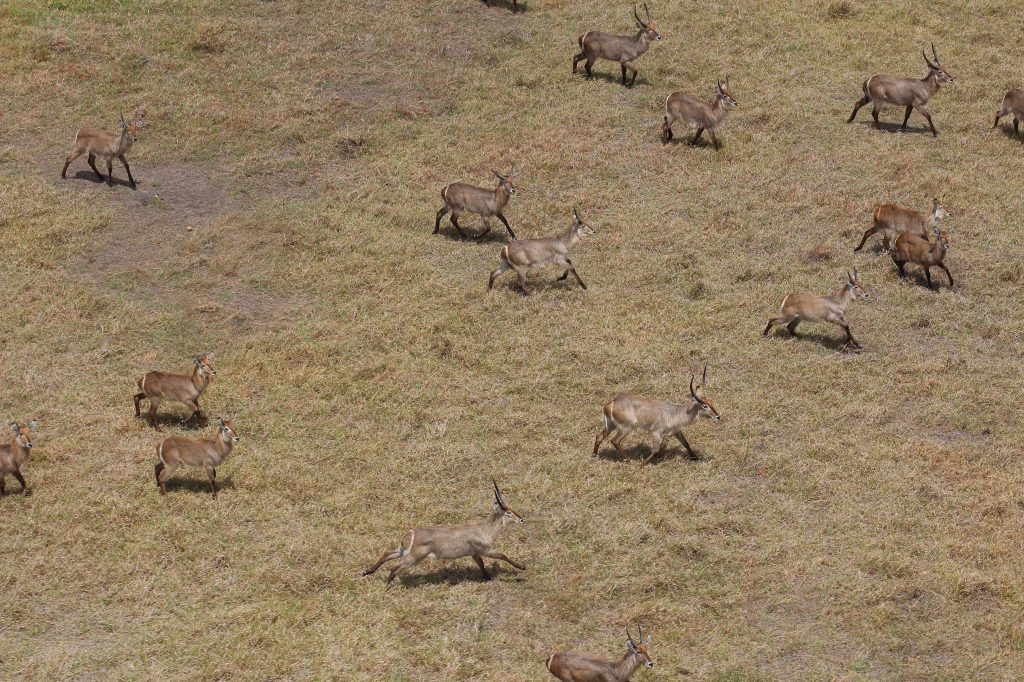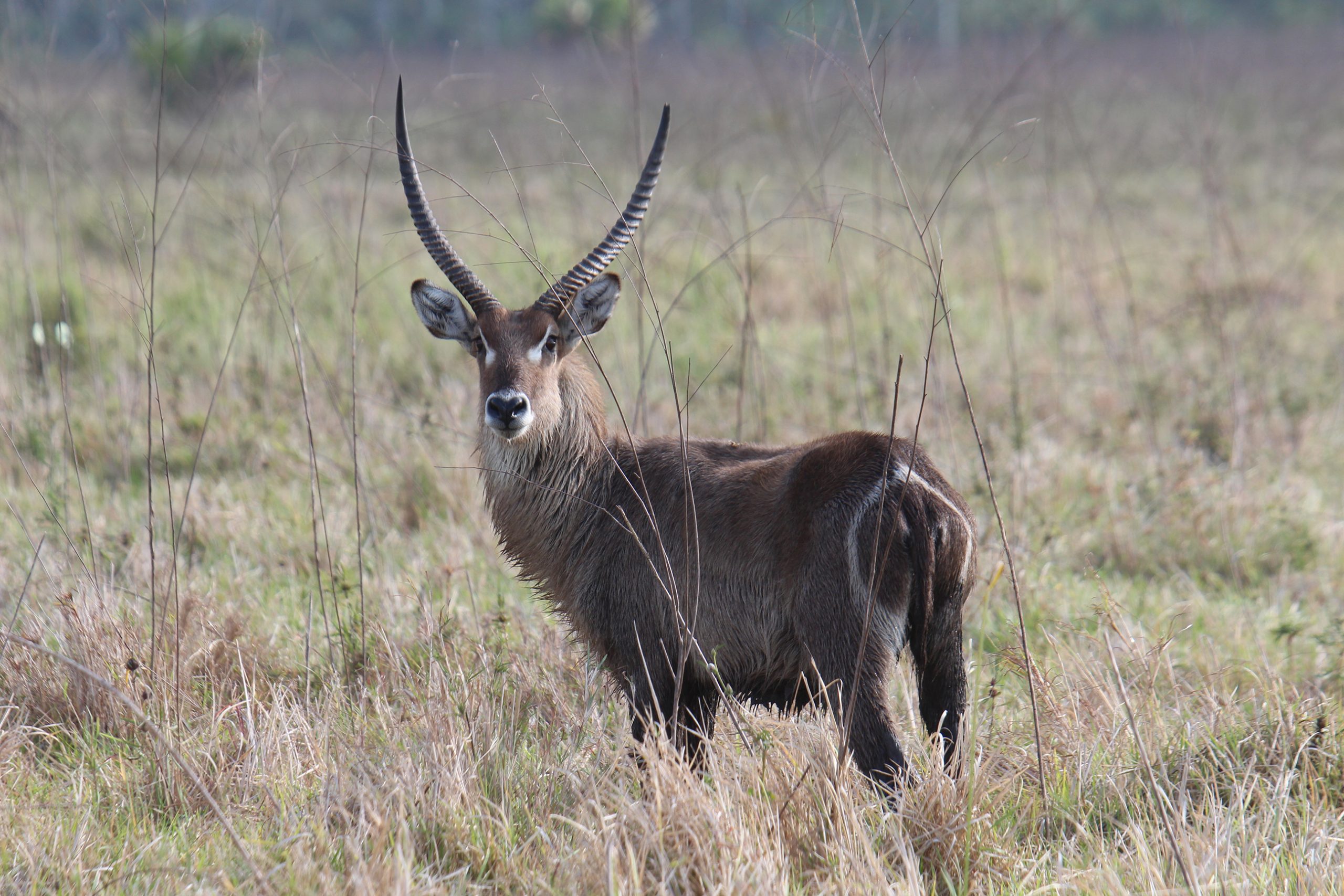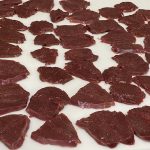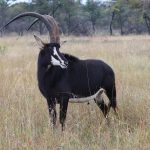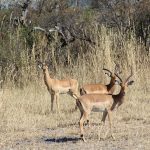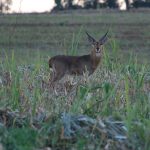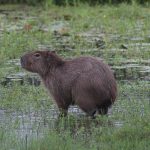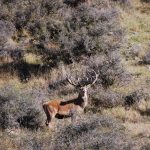Where and how to find “the most ruggedly handsome animal in Africa.”
Photo above: A good view of the weird white rump ring found on all common waterbucks. This is lacking in the defassa waterbucks, replaced by a white rump patch.
“Waterbuck are awful to eat,” quoth Robert Ruark in Horn of the Hunter, a book so good that, seventy years later, we take its observations at face value. On this one (very unusually), Ruark got it wrong. Waterbuck aren’t as tender or tasty as eland (what is?), but the meat is fine. The shaggy coat is unpleasantly oily, supposedly a natural insect repellent, which makes sense in their swampy habitat. The fix is simple: When butchering waterbuck, just take care to keep the outer skin and hair away from the meat (no different than we do with pronghorn, because of the concentrated sage). Do that, and waterbuck is perfectly fine table fare!
Ruark also described the waterbuck as “the most ruggedly handsome animal in Africa.” This one (as usual) was spot-on. With carriage “like a Scottish stag,” the waterbuck is a large, imposing antelope, a big bull weighing up to five hundred pounds, with big shoulders, straight backline, and flat belly. Unless otherwise occupied, he tends to keep his head erect, impressive horns pointed skyward.
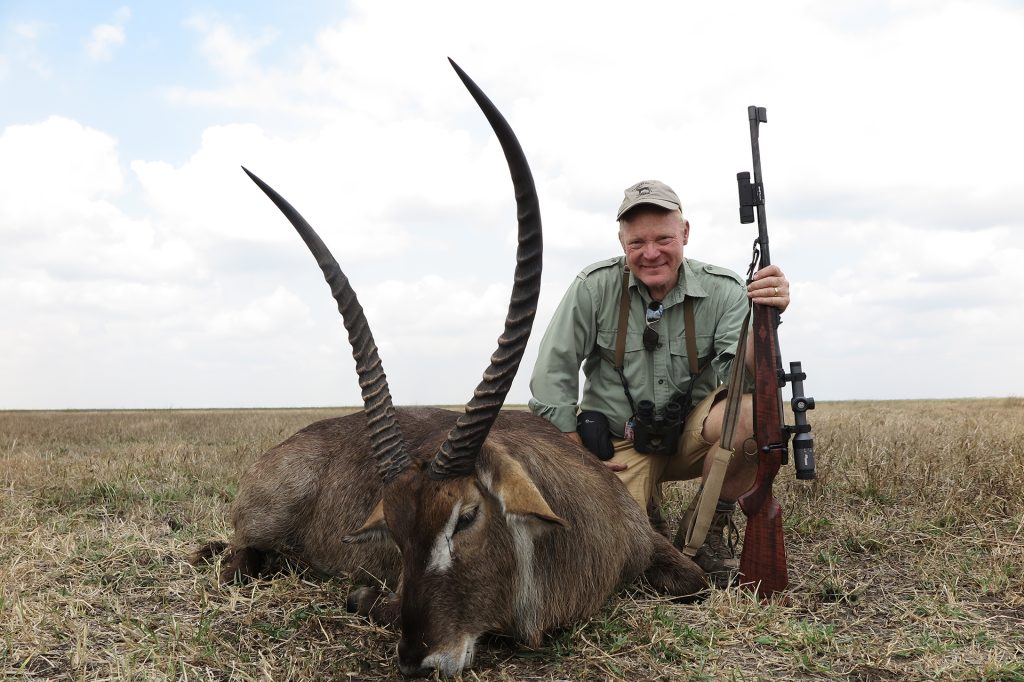
Waterbuck horns are simple: They rise from thick bases to sharp points, heavily ringed, sometimes narrow but often very wide, typically curving back, and then forward. This makes them exceptionally difficult to judge because so much length is hidden in the curve. Front-on, any mature waterbuck is impressive; it’s essential to get a good side view, because it’s the curve that takes a waterbuck from good to great.
I’ve shot several good bulls, but only a couple that made it into greatness. With all waterbuck, the magic number is 30. But, with some races and in many areas, 30-inch bulls almost don’t exist. They do get even bigger! I get a huge kick out of studying the Rowland Ward listings, our best historical record, still listing animals taken by Frederick Selous in the nineteenth century. The largest known waterbuck is an amazing common waterbuck, taken by Eugene Pearton near Alldays, South Africa, just five years ago, in 2017, with longest horn 39 3/8 inches.
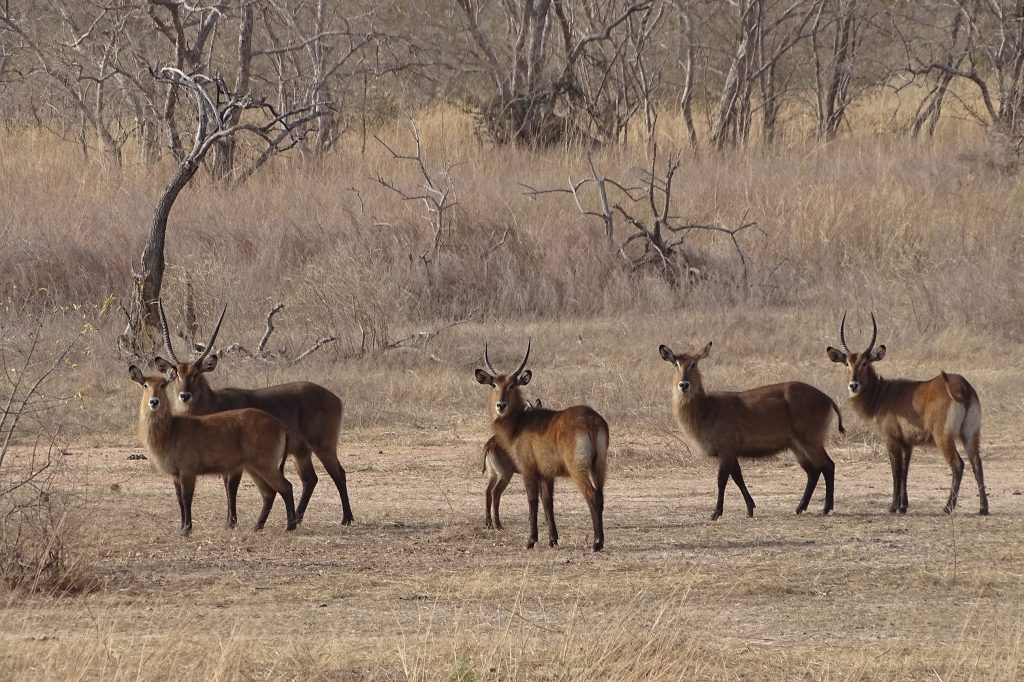
For those of us who love this stuff, it beats by an eighth of an inch the longstanding record taken in 1950 by the great African hunter, American Russ Aitken (39 2/8 on the longest horn), in South Africa. Across the races, no known waterbuck has reached 40 inches and few have come close. However, the Rowland Ward record Uganda defassa waterbuck ties Aitken at 38 2/8, and the No. 3 common waterbuck, taken in 1966 in Botswana (an arid country where waterbucks aren’t usually plentiful), reached 38 inches.
I have never seen such a waterbuck. And, with waterbuck being so difficult to judge, unless you have it on the ground and thus can use a tape, how can you know? In 2016, on the way out of the Mozambique swamps after a buffalo hunt, we spotted a giant waterbuck, certainly mid-thirties, as big as I’ve ever seen. I didn’t have a light rifle with me, just a big double. Wide-open floodplain, no cover. We tried, but we didn’t have a chance. I would have liked to put a tape on that one!
All waterbucks are the same species, Kobus ellipsiprymnos, with just two subspecies: common waterbuck with the weird white circle on the rump; and defassa, with a white rump patch. Both have varying amounts of white on throat, nose, and around the eyes. Horns are much the same, but body color varies, ranging from dark to rufous to nearly gray. The common or ringed waterbuck is one of the more widespread African antelopes, ranging from South Africa and Namibia all the way to northern Kenya. The defassa waterbuck occurs to the north and west of the common; it was long considered a separate species, but so much natural hybridization is known that modern taxonomists generally lump them as just one. In fact, there is a narrow but definable hybrid belt between the two. It starts north of where Caprivi meets Zimbabwe, then northeast and along the Malawi/Zambia border; then on north through Tanzania to northern Kenya; and on beyond up through Sudan and into western Ethiopia.
We hunters being the splitters we are, it’s surprising we’ve maintained just one common waterbuck, but the splitters prevailed with the defassa waterbucks, dividing them into regional groupings, though not with total agreement. If one were compelled to hunt them all, you could put good specimens of all six (common plus five defassa) side-by-side on a wall and I doubt anyone could correctly ID them!
From south to north, the defassa waterbucks are: Angolan, primarily in Angola but possibly extreme southwest Zambia; Rhodesian or Crawshay waterbuck, primarily in western Zambia; East African, in western Tanzania north to Ethiopia. The Uganda defassa waterbuck is identified as confined to Uganda, while the sing-sing waterbuck ranges to the west, below the Sahara and above the great forest, all the way to the Atlantic.
While general appearance and habitat vary little, horn size does. Rowland Ward’s records and minimums (based on length of longest horns) are interesting:
Subspecies Record Horn Minimum
Common 39 28
Angolan defassa 36 24
Rhodesian (Crawshay) defassa 31 25
East African defassa 35 27
Uganda defassa 39 28
sing sing 36 27
With Angola closed to hunting for forty-some years, Angolan defassa is the waterbuck we know least about, with little current data, while Crawshay waterbuck is clearly the smallest. With waterbuck on license, we’re always looking for a giant that just might hit the magical 30 inches, but, obviously, any waterbuck in the upper twenties is a very good bull (any time, any place). In Zambia’s Kafue in 1995, I saw a giant Crawshay waterbuck, another I would have liked to have put a tape on. If not 30, close. But as usual, I was on a budget. I rationalized that all waterbucks look alike. I finally shot a Crawshay waterbuck in northwest Zambia in 2010, a decent bull, but nothing like the one I passed fifteen years earlier, a bad decision. On the spot, and within reason, extra license fees are more economical than returning and trying again!
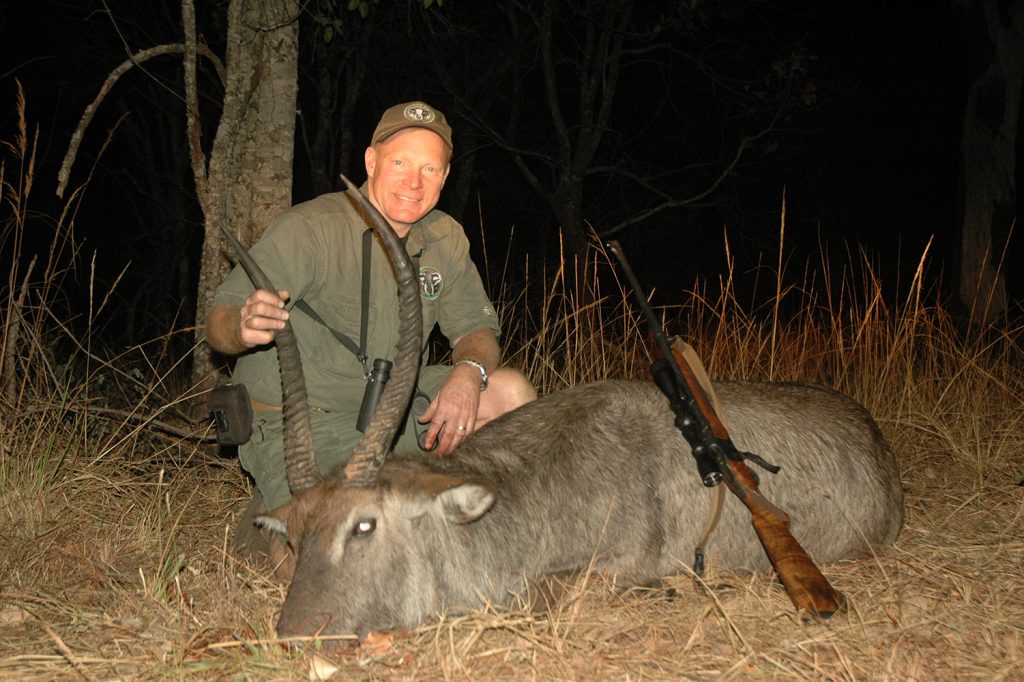
As the name implies, waterbucks are most usually found close to water, on floodplains along the edges of swamps, and in thicker riverine cover but, that said, they’re quite adaptable. An East African defassa waterbuck was one of my first African animals, taken far up on the slopes of Mount Kenya. I’ve seen the biggest numbers in floodplain habitat, but I’ve also encountered them in dry thornbush, far from obvious water.
The Uganda defassa waterbuck is legendary for its exceptional horns, longest of the defassa group. It was (and is) traditionally recognized by Rowland Ward, but not yet by SCI. This actually makes sense, because Uganda was closed from the mid-1970s for thirty-five years, during the genesis of SCI’s record-keeping system. They are again huntable, but numbers aren’t high, with little recent data. I’ve seen some big ones in and around the Murchison Falls National Park. This area is just up from the Nile, so it’s obvious waterbuck habitat. However, I’ve also seen some in acacia forest in Uganda’s northeast corner, Karamoja, arid country that seems unlikely for waterbuck! The Uganda defassa was on license all three times I hunted Uganda (2011, 2017, and 2021), cost reasonable. I’ve seen some OK bulls, but never one that beckoned, “now, that’s a Uganda waterbuck!”
Waterbuck hunting varies mostly by habitat. It seems to me they are sort of “medium” in wariness, not as crafty as the spiral horns, nor as trusting as the damaliscs. In thicker cover, I’ve seen bulls evaporate when we thought we had them dead to rights, but I’ve also seen amazing disappearing acts in wide-open country!
Because they are often seen in numbers on treeless floodplains, shooting distances can be longer than with many African animals. This is risky for two reasons: First, although you don’t hear this much, my experience is the waterbuck is among the tougher antelopes. Poorly hit, they are likely to cover much country and, if they get into wet ground (often nearby), recovery can be difficult.
Second, they are difficult to judge! To get those last couple inches of horn, you need careful views from multiple angles. Preferably as close as possible, best if there are other bulls for comparison. But you may not get a close look, and you’re unlikely to get more than one. So, if you want a waterbuck, you look as well and as hard as you can. Make your decision based on the best impression possible, but don’t dither. As with most animals, “ground shrinkage” is more common than “ground expansion.” With waterbuck, you’ll never be exactly certain until you apply the tape.
